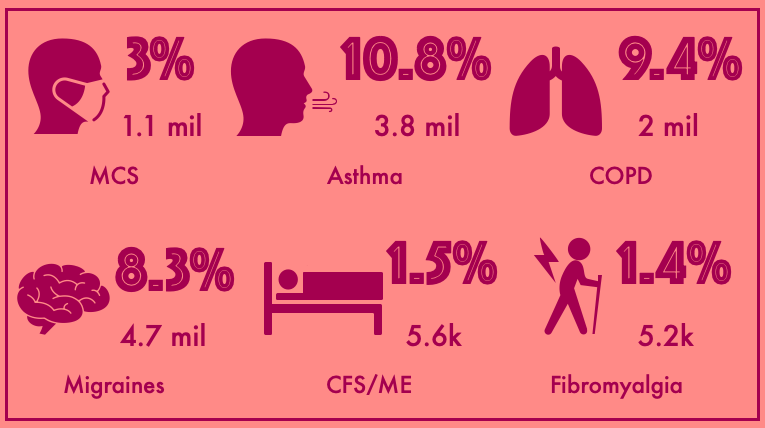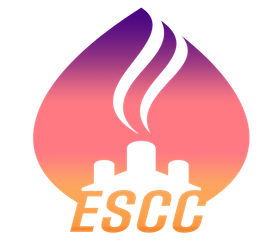
Fragrance, quat and VOC sensitivities info and accommodation guide

Who is affected by fragrances, quats and VOCs?
32.2% of the population has self-identified as having negative health reactions to fragranced products. Anyone who has a condition on our list of affected disorders could be affected. Additionally, in 2010 the Women’s College Hospital stated 3% of the population – 1.1 million Canadians have been diagnosed with multiple chemical sensitivity. A later study in America in 2018 listed 12.8% of their population had been diagnosed with MCS, which was a jump of 300% since the last report. 3.8 million people have asthma, 2 million have chronic obstructive pulmonary disease, 4.7 million people have migraines, 1.5% of the population have chronic fatigue and 1.4% have fibromyalgia, all of whom can be affected by fragrances.

What are fragrances, quats and VOCs?
Fragrances, scents, quaternary ammonium compounds (quats) and volatile organic compounds (VOCs) sensitivities are types of environmental sensitivities and can occur across many disabilities, chronic illnesses, neurological conditions and episodic health issues. Fragrance chemicals can be inherent or added in products and can be masked by use of other substances. Chemicals in fragrances can be compounded from petrochemicals or include phthalates, which are endocrine disruptors, and benzene derivatives, aldehydes, and toluene. These are known to cause cancer. Volatile organic compounds can be found in chemicals, building materials, essential oils, plants and foods and emit aerosols into the air similar to fragrances. Health Canada warns about the dangers of indoor VOCs. Quats are are cationic surfactants (surface active agents) that combine anti-bacterial and virucidal activity, they are not airborne. In a recent study they were found to disrupt cellular pathways in mice, and scientists are now calling for a review of their safety for humans.
How people respond to these substances
These substances can range from minor irritants, to triggers/precipitants and even cause some conditions depending on type of substance and duration of exposure. People with illnesses such as multiple chemical sensitivity can be affected by low level substances, which might be listed as non-toxic and imperceptible by the general population.
Negative physical responses to fragrances/scents, quats and VOCs include:
Respiratory
- breathing issues
- shortness of breath
- coughing
- COPD responses
- asthma triggers
- lung irritation
- physical damage to lung such as lesions in some conditions
Dermatological
- psoriasis
- dermatitis
- behcets
- skin irritation and dryness
- dermatomyositis
- mouth cysts, blisters and canker sores
- redness and flushing
- skin splitting
- geographic tongue
- butterfly rash similar to lupus
Urinary
- bladder spasms
- frequent urination
- increased UTIs
Rheumatological
- fibromyalgia pain
- joint pain
- muscle pain
Gynecological
- yeast infections
- bacterial infections
- exterior and interior cysts and lesions
Neurological
- migraines and headaches
- dizziness
- brain fog, loss of concentration
- memory and word loss
- vertigo
- vision issues
- muscle weakness
- fatigue
- hyperactivity
- irritability, anger and loss of emotional control
- shaking, tremors
- small fibre neuropathy
- selective mutism
Vascular
- raynaud’s syndrome (cold/blue/purple hands and feet)
- raised veins on eyes and eyelids
- petechiae and purpura (blood spots on skin)
- heart palpitations
- nose bleeds
- skin flushing
- night sweatschills/low body temperature
- livedo reticularis (mottled skin)dark circles under eyes
Gastrointestinal
- stomach cramps
- gas
- diarrhea
- constipation
- increase in stomach acid
- bloody stools
- stomach/intestinal cysts and lesions (such as in crohn’s and behcets)
While many people will only have one or two of these responses to fragrances, quats and/or VOCs, people with multiple chemical sensitivity and other more severe medical problems can have all of them at various times.
Where are these substances located?
Quats are primarily found in disinfectants. However, it is not always obvious what is causing some health issues as VOCs and fragrance can be found in various locations throughout all buildings and are also naturally occurring. They can be present in natural foods, chemically derived and in preservatives. Current labeling laws do not require product manufacturers to list origins of all their ingredients and some are allowed to be referred to simply as ‘natural flavour,’ ‘fragrance,’ ‘scent’ and ‘parfum.’ Furnishings and building materials made with plastics, rubbers and adhesives can off-gas problematic substances, especially in high heat and humid environments.
Every person with a fragrance and high VOC substance sensitivity is different. There is no universally safe product for everyone to use. However, low VOC products that do not contain quats, scents and scent-maskers are at least safer for everyone to be around and create fewer access barriers. If you are selecting products for use in public spaces, schools or businesses, the person who needs accommodation should be given samples of products to test at home, or be a part of the product selection process.
The following are lists of items which can contain problematic quats, fragrance substances and VOCs and should be considered in scent-free policies for workplaces, public buildings, businesses, transportation, healthcare and schools.

Personal products
- toothpaste
- shampoo
- conditioner
- soap
- moisturizer
- deodorants
- lotion
- makeup
- hairspray
- hair gel
- hair mousse
- toner
- exfoliants
- hair dye
- sunblock
- bug spray
- shaving cream
- hair removing wax
- after shave
- moisturizing strips on razor blades
- bath bombs
- scented epsom salts
- nail polish and remover
- liquid hand soap
- alcohol hand sanitizer (VOCs)
- benzalkonium chloride hand sanitizer (quats)
- dyed clothing and rubber on shoes
- various synthetic fabrics
- dry cleaning
- plastic, rubber and bleached period products
- latex and polyurethane condoms
- lubes, spermicidal gels and foams
- cigarettes and cannabis

Medical products
- disinfectants
- muscle pain rubs and creams
- medical lotions (many contain alcohol)
- bandaids and other adhesive strips
- plastic devices and braces
- rubber wheels on wheelchairs and other mobility devices
- latex gloves
- rubber and plastic products on machines
- anti-microbial treatments
- some elastics
- ultrasound gel
- bleached exam table paper
- salicylates in medication
- cellulose pill capsules
- various fillers in prescription medications
- various fillers in supplements
- petroleum jelly
- surgical masks

Food items
- chemical food dyes
- some natural food dyes
- preservatives (citric acid, nitrites, BHA, BHT, and sulphites are among those that commonly cause issues for people with ES. See full list of allowed preservatives in Canada.)
- some gums and thickeners
- pesticides on foods including some approved as organic
- anti-sprouting agents on root vegetables
- anti-fungal sprays used to keep berries, fruit and citrus fresh in travel
- fruit waxes
- some sugars and sugar substitutes
- high FODmap foods and drinks
- naturally occurring pesticides and acids in vegetables (oxalates, capsaicin, alpha-chaconine, alpha-solanine, nicotine)
- lectins and acids in fruits and seeds
- alcoholic beverages
- salicylates
- natural sulphites
- dairy (dairy processing equipment is often cleaned using quats)

Building materials and industrial
- high VOC paints
- high VOC adhesives, caulking, glues
- dry wall
- various insulation types
- glazes and sealants
- rubber gaskets
- plastic pipes and fittings
- laminate flooring
- PVC flooring
- pollution
- fireworks
- emissions from any gas or diesel powered vehicles

Cleaning products
- dish soap
- dishwasher pellets
- floor cleaner
- disinfectants
- toilet cleaners
- glass sprays
- oven cleaners
- clothing detergents
- dryer sheets (always scented)
- bleaches (always high VOC)
- fabric softener (always scented)
- pet stain sprays
- magic erasers
- carpet powders
- dust sprays
- citric acid products

Household items
- air freshners
- gaskets on dishwashers and stoves
- interior coatings in ovens
- furnishing made with chipboard
- plastic window blinds
- plastic items and furnishings
- plastic and rubber wheels on rolling furniture
- gas stoves
- gas furnaces
- gas water heaters
- paints
- art supplies
- memory foam products
- plastic and rubber toys
- carpet fibres and backing
- candles and incense
- plastic and rubber toys
- plastic and rubber dishes
- some baby bottles nipples and soothers
- dust

Office products
- printers and prink ink
- some dry erase markers
- sharpie markers
- gases from new computers, phones and other electronic devices
- gases and oils in automatic lift chairs
- keyboard dust sprays
- laminating machines
- 3D printers
- chalk
- printed books

Naturally occurring
- tree saps and pitch (pinene, picea, and others)
- essential oils
- edible plant terpenes (such as mint, rosemary, basil, limonene, and others)
- many cannabis terpenes
- molds and VOCs from decaying plant matter
- VOCs found in pollens
- gas
- petroleum oils
- wood smoke
- dust

Dental products
- nitrous oxide
- mercury fillings and mercury vapour from drilling
- acrylic dentures
- dental adhesives
- quat based tool disinfectants
- Eugenol, local antiseptic/analgesic
- Copalite (Harry Bosworth, R), cavity varnish
- Scotchbond One (3M/ESPE, R), dental adhesive
- Bacillol (Bode, R), surface disinfectant
- Kalocryl (Speiko, R), acrylic substance
- flavoured/scented fluoride treatments
- dental floss with PFHxS
- resin fillings
How do I avoid these substances and make my space accessible?
At first glance, this is an overwhelming list. These items are very pervasive and as many already exist in building structures, they are unavoidable. However, there are processes to off-gas many plastics, rubbers, and adhesives. There are methods to clean up spaces previously affected by fragrances, quats and high VOC products and reduce the aerosol effects these products have. Some fabrics can be treated. Many solutions, like simply choosing new cleaning and personal products that are less harmful are easy to implement and are great first steps in making your location accessible for people with environmental sensitivities.
Fragrance free policy
Create signage, send emails and post on websites and community announcement areas that your space has a fragrance free, low VOC policy. Request that people entering the space at minimum wear no perfumes, colognes or essential oils and then educate them on the various personal products they use that can contain these substances so they can begin researching alternatives that fit with their lifestyle for use in accessible areas.
If a sensitive person indicates someone is wearing fragrances that are harming them, ask that person to leave if possible and explain the policy. If it is not possible for the person to leave, keep them in an area away from the sensitive individual. Ensure they understand the policy so that future infractions are avoided. Unenforced fragrance free policies are not accessible.
Off-gassing and ventilation
High heat and UV is the best method to off-gas rubber, plastics, adhesives and fragranced items that emit harmful aerosols. By leaving products out in the sun, or cranking up the heat in a building with the windows cracked, you can reduce the effects of many problematic items and areas previously cleaned with scented/high VOC/quat products.
While Canada advises against using ozone generators in homes, ozone and vaporized hydrogen peroxide sterilization may be helpful in reducing VOCs and fragrances. These must be done by a professional and the space must be aired out and properly vented for a minimum of 48 hours after treatment before people can return. We do not recommend buying ozone machines to treat spaces yourself. The EPA warns against the use of personal ozone based air purifiers for the home. The EPA writes that the level of ozone that home ozone units emit, is not sufficient to remove odours and VOCs. While ozone is effective at treating VOCs in high doses, the level required is harmful to humans. At these doses it can also damage plants, paint, electric wire casings and rubber. If possible, only ozone treat an empty space before you move in. The Washington Post (paraphrasing an ozone treatment specialist) writes, “To prevent damage to the plastic coating on electrical wires, trained technicians run an ozone generator for only two to four hours at a setting that is safe for wiring. Then they leave the house closed for two full days, allowing the ozone molecules to do their work. The technicians air out the space before people and pets move back in.” Should you choose to use professional ozone treatment, be sure to ask potential providers about their methods to ensure your property is not damaged. In addition, as surface off-gassing can create more contaminants, all surfaces should be washed after any treatments.
High humidity causes some household items to off-gas infinitely. One study shows this is especially true of architectural coatings, cleaning agents and moth balls. Use of a dehumidifier lowers the aerosols created by various products that can off-gas.
Proper air flow and ventilation is necessary to remove offending air and gases and is also helpful in pandemic safety. Running your HVAC system constantly may cost a bit more, but it will keep the air fresh and help people with ES safely access your space. Having a charcoal filter on your HVAC to absorb fragrances and VOCs and changing your filter as indicated by the manufacturer will also help. Use of an UV-C HVAC may break down VOCs, but it is still advisable to add charcoal filtration to all air purification systems for maximum benefit. People who are very sensitive may require an additional air purifier with charcoal filter in the room to help with air quality. Weather permitting, open windows will help ventilation and air flow.
Location of problematic items
Offices and schools
Keep printers, print inks, high VOC art materials and other off-gassing items in a separate closed-off room with proper ventilation. If someone with ES has to use these items as a part of their job or project, run an air purifier in the space.
Stores
If you sell scented products, ensure all scented items are in air tight packages. Open soaps in grocery stores are among the worst offenders for accessibility.
Locate your scented cleaning products on the opposite side of the building far from the entrance. Create a section for your unscented personal care and cleaning products that is far from your scented items. Do not locate food items near scented products as they can absorb the fragrances. Place an air purifier at the entrance of your scented product section.
Do not burn candles or incense. These smells permeate all products and often cannot be removed from fabrics. You not only create an inaccessible space, you limit the amount of customers who can purchase items at your store curbside and online.
Safe Products
Baking soda and natural vinegars are the base level of cleaning product most highly sensitive people with ES use in their homes. Some people cannot tolerate vinegar. During the pandemic, unscented soaps and detergents are recommended to clean. Many of our working group members do best with Seventh Generation unscented and Nature Clean unscented products. Nature Clean has the added benefit of being a Canadian company, should you be trying to shop local. We are not affiliated with these companies or any companies that sell these products.
As twenty seconds of hand washing has been shown to effectively disrupt the protein that envelopes the Covid-19 virus, thoroughly cleaning spaces with unscented soaps is a safe alternative to disinfectants. The CDC even lists cleaning with soap to be sufficient unless someone with Covid-19 has been in the house in the last 24 hours. Health Canada states that there is no proof that hand sanitizers kill the virus, but they can lower transmissions. As all hand sanitizers are not safe for people with ES, we recommend frequent hand washing with unscented hand soaps.
This list of non-toxic products is recommended by CASLE and the Women’s College Hospital Environmental Sensitivities clinic in Toronto, but it has not be updated since 2011.
The Environmental Working Group is a tool to look up ingredients in products to see if they are considered fragrances, but they list an overall letter grade rating of products that does not weigh fragrances, quats and VOCs as a fail for the product. As such, we do not recommend them for product selection. They are funded in part by Beautycounter, Beauty Juice and Dr. Bronner, all of whom make products that contain fragrances and VOCs, so they are not a reliable source of product safety for people with ES. They are also funded by Brown Advisory Group, which is an investment firm which could sway their product recommendations towards products they have invested in. They often are out of date on ingredient listings so be sure to check the label of products to see if they match the database.
Treating fabrics
Use of a wet vacuum system with hot water and unscented soaps can remove offending substances from many fabrics such as carpets and furniture. A mix of natural white vinegar and water using similar methods can also help should the unscented soap not be sufficient. As with rubbers and plastics, heat and UV are very effective methods of off-gassing fabrics. However, some fabrics will retain the offending substance and cannot be treated and must be replaced. This is most common with fabrics that contain synthetic fibres, PVC and other plastics. For clothing and pliable fabrics, many have had success in soaking the item in a mix of water and vinegar, for up to a weeks time then rinsing. Some items take multiple treatments before they are able to be used.
Healthcare
Dentist offices
A 2008 study in Athen Greece found twenty times the recommended level of VOCs in the air, largely from surface and tool disinfectants being used. They tried different types of natural ventilation in order to examine their effect on the air quality, and found that double cross-ventilation was the most effective. A high quality air purifier in each room and an open window is recommended. In rooms without windows, two air purification systems should be used to create cross ventilation.
Dental staff should wear fitted carbon filtered masks while performing all disinfecting, mixing of substances and vapour inducing processes. Patients should not be in the room while any disinfectants are being used and there should be a significant wait after cleaning the area to allow for VOCs to be cleared by air purification systems.
Product choices should be rethought. In California, they have a 1% VOC maximum limit on products allowed to be used in medical facilities. Unscented soaps should be used in place of surface disinfectants. UV and heat sterilization of tools should be used in place of quat and alcohol disinfectants. Office floors should be cleaned using unscented soaps and detergents.
Medical facilities and hospitals
VOC hazards to patients and staff in medical facilities are very high. In this 2012 study, they found: “The patient/personal cleaning task using products containing chlorine was associated with elevated levels of personal chloroform and α-pinene exposures. Tasks associated with instrument sterilizing and disinfecting were significantly associated with personal d-limonene and 2-propanol exposures. Surface and floor cleaning and stripping tasks were predominated by housekeepers and floor strippers/waxers, and use of chlorine-, alcohol-, ethanolamine-, and quaternary ammonium compounds-based products was associated with exposures to chloroform, α-pinene, acetone, 2-propanol, or d-limonene.”
All healthcare providers should have high quality carbon filter air purification devices in offices and rooms without proper HVAC systems, especially in rooms without windows. They should use unscented hand soaps before exams, rather than hand sanitizers, which have not been shown to kill the Covid 19 virus.
For tool sterilization, steam, dry heat, plasma gas sterilization, vaporized hydrogen peroxide, ultrasonic and UV-C methods all currently exist. These are all safer choices for staff and patients. We should be moving away from using inaccessible products and investing in these human and environmentally safe options.
UV-C disinfectant systems have been found to be effective at killing ebola, K pneumonia, C diff, MRSA and VRE and have been used with great success at various hospitals internationally. They also are used in the nighttime cleaning of laboratories and meat packing facilities. UV-C HVAC systems exist. These systems should be used in all healthcare facilities to enable the use of less harmful products such as unscented soaps and detergents for a healthy safe full sanitization process that eradicates microbes and is accessible to staff and patients. This 2019 study found that the combination of UV-C and surface cleaning yielded the best results. The ESCC would like to see local testing within Canada of this process beginning with MCS/ES safe patient rooms in every hospital that only use these two methods.
Currently hospitals are not accessible to patients with ES who react to fragrance, quats and VOCs. If the disinfectants which cause the bulk of the issues were no longer used, no additional protocols would be needed. As is, hospitals should have a process in place and ‘safe’ rooms where no offending products are used and proper air purification exists. Otherwise, they are not providing equal access to healthcare and failing to live up to the Accessible Canada Act.



Very useful indeed……..(for my coming soon medical and dental appointments.) Thank you.